 |
| Derek Anderson, Plant Ecologist/ Botanist |
 |
"On September 16, I followed up on a tip from a member of the Mower County Audubon Society. I had given a presentation to the group the night before, and one of the women attending the meeting mentioned a small cemetery located in the northeast corner of the county. I was told it was located behind the manicured portion of the cemetery. She remembered seeing several of the plants that I had pictures of in my presentation. I went out to the site, and was delighted to find over 40 different prairie forbs, including four listed species: Wild Quinine (Parthenium integrifolium), Endangered; Rattlesnake Master (Eryngium yuccifolium), Special Concern; Plains Wild Indigo (Baptisia bracteata), Special Concern; and White Wild Indigo (Baptisia alba), Special Concern."
 |
| Dan Wovcha, Plant Ecologist/ Botanist |
 |
"In the first week of September, MCBS ecologist Janeen Ruby and I were the beneficiaries of a prescribed burn done earlier this year at Chippewa Prairie Preserve in Swift County. We were at the preserve to complete some prairie monitoring transects (see July 7th entry below) and were surrounded as we worked by a profusion of wildflowers brought on by the spring fire."
 |
 |
| Dan Wovcha, Plant Ecologist/ Botanist |
 |
August 25, 2009. "I joined MCBS plant ecologist Michael Lee recently for a field outing near Brule Lake in the southeastern corner of the Boundary Waters Canoe Area. The first day of our trip, we paddled into the wilderness with 4 washing-machine sized packs in our canoe and set up camp on a large island in the west end of Brule Lake before we had to make any portages. When we landed at our campsite I realized that I had camped there once before and that it was wet and inhabited at night by a bear. For the next eight nights we slept fitfully and set out from camp in the morning to visit steep, slippery cliffs and talus slopes and small isolated wetlands north of the lake to look for rare plants and record notes about the vegetation. During our stay in the wilderness we had several hours of perfect weather and more-or-less reached a stalemate with the mosquitoes that lived in the bushes at the edge of camp and flew out when they heard our tents unzip in the morning: they fed on us as at will and we squished as many of them as we could. Several highlights of the trip: a device Mike had for hanging our food that was more bear-proof than any I had seen before and made me think, now the bear will come directly to my tent and not mess around with the food pack; a jumping mouse that managed to sound a lot like a bear in our camp at 2:00AM every night by jumping into our aluminum cooking pot; a very fat toad that managed to sound a lot like a bear rustling under the vestibule of my tent one night, about half an hour after the mouse had jumped into the cooking pot; neither of us was very high up on a cliff or in sight of the other when we slipped and fell on our rears on wet mossy pointy rocks; and Mike found a dozen new locations for rare plant species, including maidenhair spleenwort (Asplenium trichomanes) on the first talus slope we looked at and montane yellow-eyed grass (Xyris Montana) on a mud flat in a shallow lake that had dropped in recent years following the breaching of a beaver dam. Mike also found Michaux's sedge (Carex michauxiana), sooty-colored beak-rush (Rhynchospora fusca), and the diminutive annual grass one flowered muhly (Muhlenbergia uniflora) in some of the wetlands we visited, and possibly a rare species of Huperzia on a north-facing cliff at dusk in a steady rain about two hours north of our campsite on our last evening out. That evening we also saw the largest bull moose either of us had ever seen, making its way down a slope a few yards below us before disappearing over a ridge in a burned forest that stretched as far to the north as the eye could see."
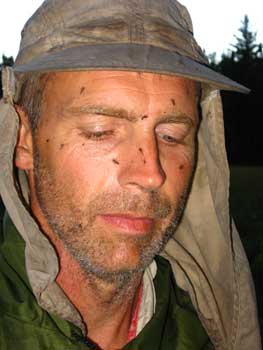 |
 |
| Derek Anderson, Plant Ecologist/ Botanist |
 |
August 24, 2009. "I had a few surprises during the week of August 17. Typically the fields of southern Minnesota are dominated by corn and soybeans. However, on August 18, I came across a field of onions. On August 19, I was contacted by an individual I met last year in Mower County. He had found a large plant growing in the ditch near a small stream. The large size of the plant and odd shape of the leaves left him wondering if this was an invasive species. I met up with him, and he took me out to the plant. I was surprised to see that the plant in question was glade mallow (Napaea dioica), a threatened species! We then checked other areas along the creek, and found the plant in two more locations."
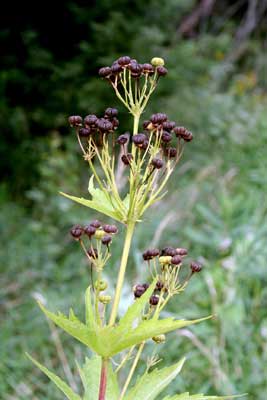 |
 |
| Rebecca Holmstrom, Plant Ecologist/ Botanist |
 |
August 21, 2009. "For the past several weeks I have been spending time in some of the small basin and larger peatland complexes of the Nashwauk Uplands subsection (central St. Louis County) surveying the native plant communities and searching for rare species. Beyond the generally delightful experience of exploring these peatland systems, there have been a number of other notable highlights including new rare species observations for montane yellow-eyed grass (Xyris Montana), Round-leaved sundew (Drosera rotundifolia), coastal sedge (Carex exilis), and the small green wood orchid (Platanthera clavellata). One large poor fen water track also hosted extensive populations of the state-listed bog rush (Juncus stygius var. americanus) and sooty-colored beak rush (Rhyncospora fusca). "
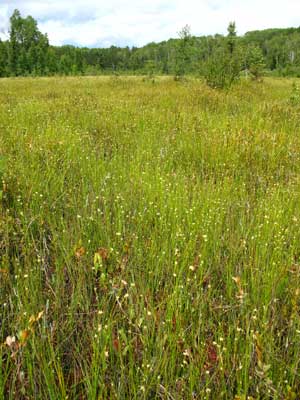 | 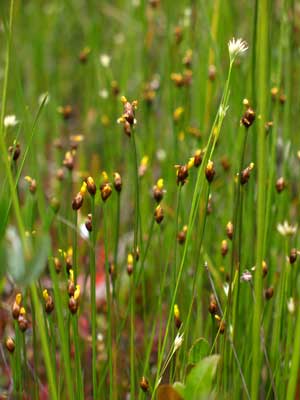 | 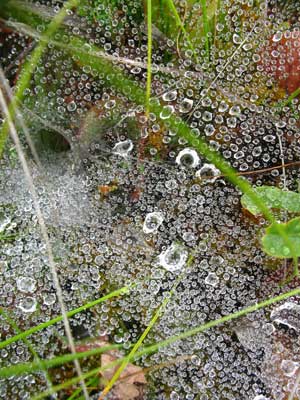 | 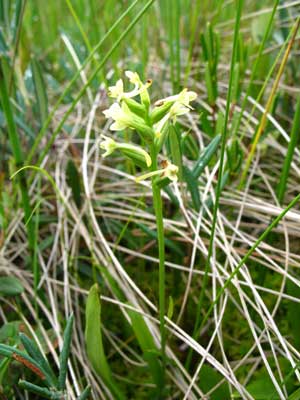 |
 |
| Steve Stucker, Ornithologist |
 |
August 20, 2009. Steve reports that MCBS ornithologists made 19 new observations of Pine Warblers (Dendroica pinus) in the Border Lakes Subsection in Cook County during surveys this field season. Pine Warblers had previously been documented at 226 locations in Minnesota but there were few records from northeastern Minnesota and none from Cook County. The species is closely associated with forests dominated by relatively mature pines.
 |
| Fred Harris, Plant Ecologist/ Botanist |
 |
August 20, 2009. "Cattail marshes dominated by our native broad-leaved cattail (Typha latifolia) can be very hard to find these days in Minnesota's prairie region. Over the last century, many marshes disappeared due to drainage for agriculture. Most remaining marshes have been invaded and taken over by the narrow-leaved cattail (Typha angustifolia), which is native to the eastern coastal regions of the U.S. but not Minnesota.
Surveying native habitats in Norman County, I found some native cattail-sedge marshes, but all of them were undergoing narrow-leaved cattail invasion. One of my best finds was in Syre WMA (east unit): a broad swale dominated mostly by native sedge meadow with a central zone of mixed cattail-sedge marsh. The outer edges of the marsh zone are dominated by broad-leaved cattails and sedges. Narrow-leaved cattail has become established in the deepest water in the center of the marsh where it has crowded out all vegetation. The transition from the native cattail-sedge zone to the much taller, darker narrow-leaved cattails is very abrupt and looks like a dense wall."
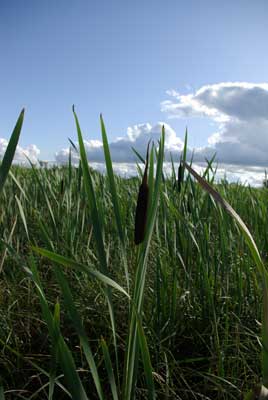 |
 |
| Carmen Converse, MCBS Supervisor |
 |
Carmen spent August 6-12 with Lawson Gerdes in the far northeastern part of the Boundary Waters Canoe Area near Rose Lake, surveying native plant communities and searching cliff habitats for rare species. One of the highlights of the trip was the discovery of a population of Braun's holly fern (Polystichum braunii) numbering several hundred plants along a creek bed in an old-growth forest of massive black ash and white cedar trees at the base of a northeast-facing ridge. Braun's holly fern is a state-endangered species that previously had been documented in Minnesota at just a few locations in the North Shore Highlands near Lake Superior in Lake and Cook counties. Carmen and Lawson found several other rare plants during the trip, including the cliff-dwellers maidenhair spleenwort (Asplenium trichomanes) and Rocky Mountain woodsia (Woodsia scopulina), and Torrey's Manna-grass (Torreyochloa pallid) in a sedge meadow.
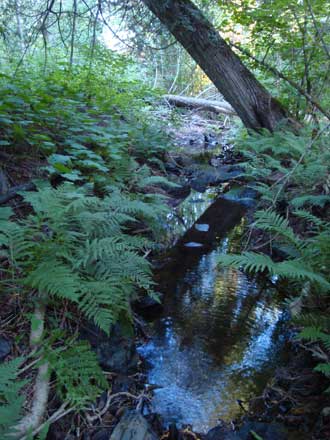 |
 |
| Ethan Perry, Plant Ecologist/ Botanist |
 |
August 6, 2009. "Had an exciting week. On Tuesday and Thursday I found 2 new locations for the Bog adder's mouth (Malaxis paludosa), an endangered orchid that is notoriously difficult to find. Along with a location found earlier this year in Itasca Co. by Jason Husveth and another found last year in Cass Co. by Scott Milburn, these new locations extend the known range of this species in Minnesota east from the region around Itasca State Park. I found 3 plants at one location and only a single plant at the other, but in both cases it was the end of the day, and more extensive searching will be necessary to get a better idea of population sizes. "
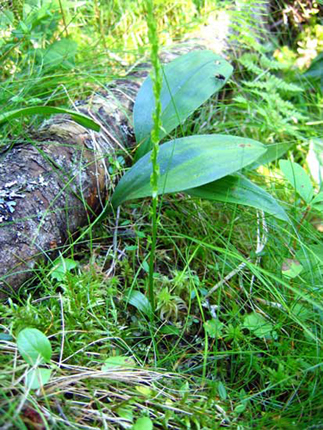 |
 |
| Derek Anderson, Plant Ecologist/ Botanist |
 |
"On August 6, 2009 I found a nice prairie remnant located along a township road in southwestern Mower County. The mile to two mile stretch was very diverse and had some very great species. Some of the common species included compass plant, big blue stem, Indian grass, prairie phlox, purple prairie clover, blazing stars, goldenrods, sunflowers, and lead plant. Some of the rare species included: rattlesnake master (Eryngium yuccifolium) and Sullivant's milkweed (Asclepias sullivantii). However, the most exciting find was prairie milkweed (Asclepias hirtella). This find is only the second location in the entire state for this species!"
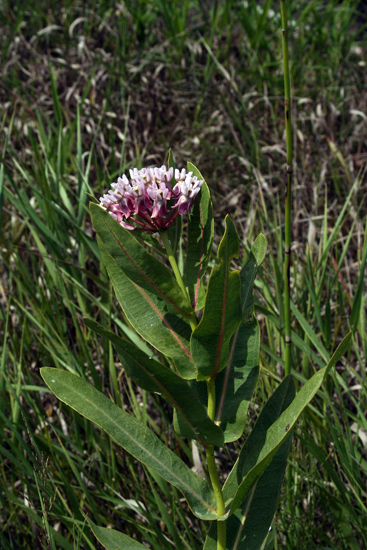 | 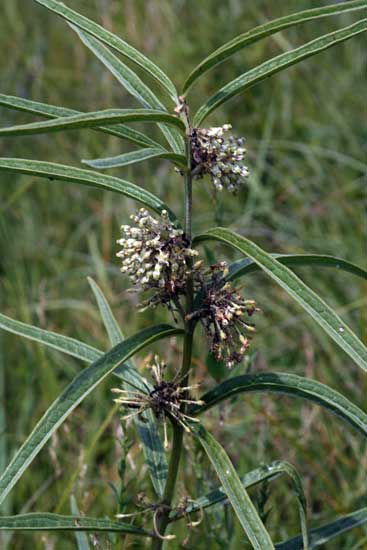 |
 |
| Derek Anderson, Plant Ecologist/ Botanist |
 |
"In late July and early August, I went out with the park staff to look at remnant communities of Lake Louise and Rice Lake State Parks. The visits were great, and we found a number of listed species. At Lake Louise State Park, we saw Wild Quinine (Parthenium integrifolium), White Wild Indigo (Baptisia alba), and Yellow Pimpernell (Taenidia integerrima), a species being considered for special concern listing. Prior to my visit, park staff also found a small population of Lily-leaved Twayblade (Liparis lilifolium). My visit to Rice Lake State Park was just as exciting. We visited a small prairie remnant in the park, and found a variety of rare species including Valerian (Valeriana edulis), Sullivant's Milkweed (Asclepias sullivantii), Wild Sweet William (Phlox maculata), and Cowbane (Oxypolis rigidior)."
 |
| Stacey Olszlewski, Plant Ecologist/ Botanist |
 |
July 22, 2009 "I've been having a great time by myself out in the field, but I've had a strange 'Alice in Wonderland' past few days...while wandering around, no matter if I went this way or that, I somehow always ended up stumbling upon big piles of mushrooms. This was all well and good, but when a friend randomly informed me that the term "Mad Hatter" comes from the fact that people who made top hats over a century ago would go mad from the mercury used in the lining, I started to wonder upon the theme of my week. I asked him why he told me that, and he responded only with a big, wide, toothy grin. Now I'm just waiting for a white rabbit.
On another note, I found a really great poor spruce conifer bog in the southwestern part of Cass county, situated right next to a pure jack pine stand. I found a similarly spectacular mossy jack pine stand near Pine River a few days ago, a nice surprise since there are very few natural-origin jack pine stands left in north-central Minnesota."
 |
| Lawson Gerdes, Northern Coordinator, Plant Ecologist/Botanist |
 |
July 21, 2009 "Although my Border Lakes field survey areas are within and outside the BWCA wilderness, and include areas of the 1999 blowdown, and recent and successive fires, as well as managed and primary forest, the goal is the same. Interpret the condition of the landscape, the quality of the native plant communities, and improve our understanding of the distribution and ecology of rare species. Identify the highest quality areas of statewide biodiversity significance in the Border Lakes subsection.
My field assistant and I just returned from conducting surveys in the Granite River, Sag Corridor and Grandpa Lake areas. What we observed transcended space and time. Vast areas experienced a rapid succession of fires over the last few decades. For some portions of the area, fire swept through the 1999 blowdown, in other areas, through primary forest. Portions were hit by the Ham Lake, Sag Corridor, Alpine and Roy Lake fires, consuming primary and recovering conifer forests alike. The response? In some areas recovering woodlands dominated by jack pine, black spruce and aspen are intact. In other areas, with conifer seed sources extremely limited, wind-disseminated seeds of aspen and birch blow in to fill the niche. Resulting in patches occupied by less-than-vigorous saplings, eking out a living on a bit of soil over bedrock.
What about existing biodiversity? The creeks and drainages, lowland conifer forests and open peatlands, unburned patches, intact microsites on burned-over northeast-facing cliffs, and intact primary forest patches we surveyed appeared to be refugia and potential source areas for plants and animals alike. We noted a strange mix of generalist and specialist bird species, packing into places where burned over areas edged small, residual forest patches. We searched for rare plant species that might take advantage of wind-toss and exposed soil and bedrock, such as Franklin's phacelia (Phacelia franklinii) or Allegheny vine (Adlumia fungosa). We also surveyed patches of "high-quality" young forest; areas with the composition and structure (high potential) to become older growth stages of the native plant community. Along the way, wetland and shoreline aquatic habitats were sampled as well as the intact, primary forest communities (woodlands) of the Sag Island chain. These survey areas have forced me to take the notion to the extreme that biodiversity significance is related to the landscape in which we are working. My hope is that land managers can use the information we are gathering to help assess the value of source areas and refugia, and make wise decisions about practices such as the use of prescribed fire and the restoration of conifers in this landscape. The field season is 1/2 over - lots of work left to do - gotta go!"
 |
| Dan Wovcha, Plant Ecologist/ Botanist |
 |
On July 7th and 8th, several MCBS members joined up with staff from the Nature Conservancy and the U.S. Fish and Wildlife Service for prairie monitoring training in southwestern Minnesota. This is the third season of the multi-agency monitoring project, which is looking at the effects of fire and grazing management on the quality of native prairies in western Minnesota and eastern North and South Dakota.
 |
| Stacey Olszewski, Plant Ecologist/ Botanist |
 |
6/30/2009 1:45 PM. "Last week was a pretty -yellow- week in the field. I saw beautiful yellow lady's slippers (Cypripedium calceolus) and also unexpectedly came across a stand of my favorite tree, yellow birch (Betula alleghaniensis), which turned out to be a new species record for southern Cass County :)
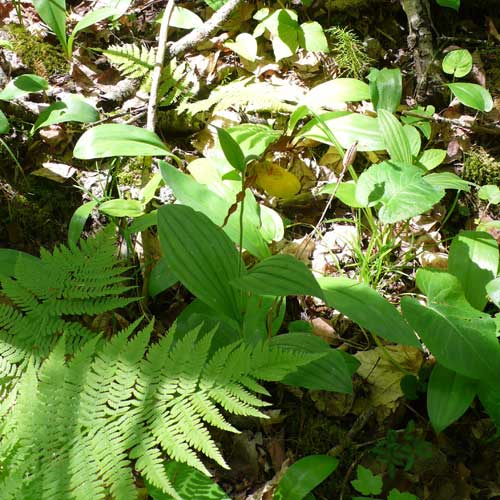 |
 |
| Jason Johnson, Plant Ecologist/ Botanist |
 |
On June 26 Jason joined a team of orchid hunters on a search for the state-threatened ram's head lady's-slipper (Cypripedium arietinum) in Beltrami County. The group found 1,200 orchids over the course of two days! A few days earlier on June 19, Jason heroically rescued at least three turtles he found wandering along the road, but arrived at the scene too late to save the nest of another turtle from plunder. One of Jason's other summer adventures has been to stop mowing his yard and see what appears.
 |
| Erika Rowe, Plant Ecologist/ Botanist |
 |
June 19, 2009 "Participated in a count of a large population of ram's-head lady's-slipper (Cypripedium arietinum) in Beltrami Co. with folks from the Forest Service, Leech Lake Reservation and volunteers. A large portion of the lady's-slippers were an unusual white variety."
 |
| Erika Rowe, Plant Ecologist/ Botanist |
 |
June 17, 2009 "A productive day in the field. Found a small population of cuckoo flower (Cardamine pratensis), the second population I found this year, around a sedge dominated shoreline. It is currently a tracked species, but proposed to be listed as a State Threatened species. I found it growing along with 100s of dragon's mouth orchids (Arethusa bulbosa) another tracked species. In the same wetland complex, in an adjacent cedar swamp, a large population (~1000 plants) of northern oak fern (Gymnocarpium robertianum), proposed as a Special Concern species, fairy slipper orchid (Calypso bulbosa), and the State Threatened species ram's-head lady's slipper (Cypripedium arietinum). I also stumbled upon a very curious thing late in the day: a rotten old suitcase (hard to tell how old it was) in the middle of a cedar swamp filled with sea shells from large to small and other odd items such as carved wooden boxes, claws and small skulls. A bit creepy. It had clearly been there for a very long time. Animals have now strewn the sea shells across the sphagnum carpet making a very strange scene."
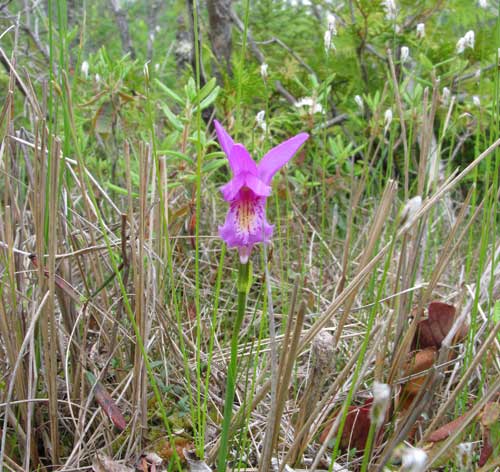 | 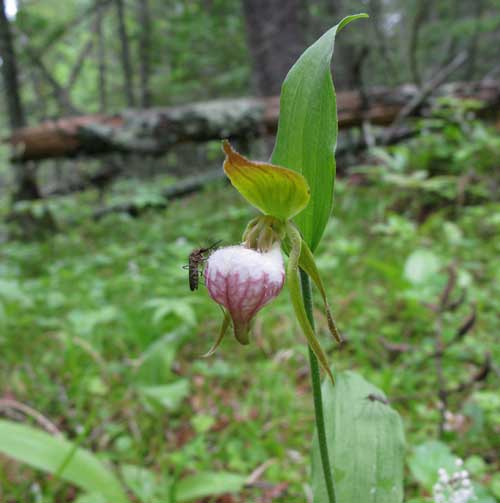 |  |  |

